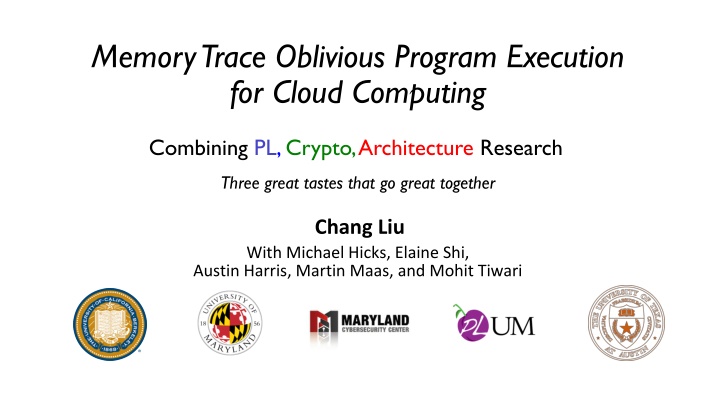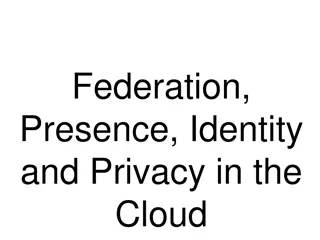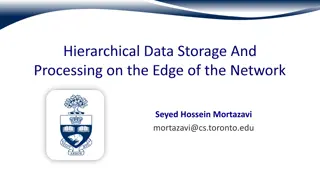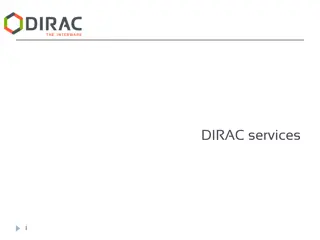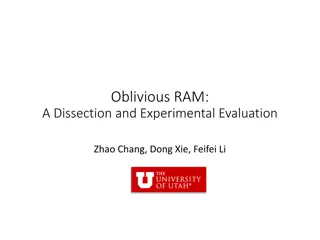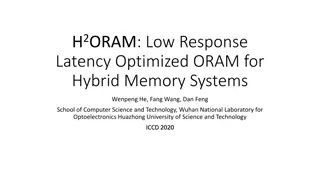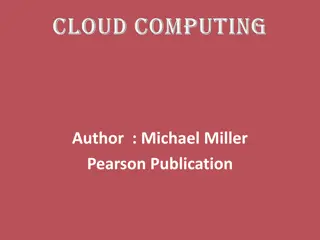Memory Trace Oblivious Program Execution for Cloud Computing
This research delves into the intersection of programming languages, cryptography, and architecture to address privacy concerns in cloud computing. It discusses the risks posed by physical attacks on sensitive data and explores solutions like secure processors and Oblivious RAM to safeguard information from access pattern leakage.
Download Presentation

Please find below an Image/Link to download the presentation.
The content on the website is provided AS IS for your information and personal use only. It may not be sold, licensed, or shared on other websites without obtaining consent from the author.If you encounter any issues during the download, it is possible that the publisher has removed the file from their server.
You are allowed to download the files provided on this website for personal or commercial use, subject to the condition that they are used lawfully. All files are the property of their respective owners.
The content on the website is provided AS IS for your information and personal use only. It may not be sold, licensed, or shared on other websites without obtaining consent from the author.
E N D
Presentation Transcript
Memory Trace Oblivious Program Execution for Cloud Computing Combining PL, Crypto, Architecture Research Three great tastes that go great together Chang Liu With Michael Hicks, Elaine Shi, Austin Harris, Martin Maas, and Mohit Tiwari
Cloud computing raises privacy concerns for sensitive data Financial Medical Government etc. Data & Program Run analysis over the sensitive data
Malicious insiders or intruders may perform physical attacks to snoop sensitive data Insider Intruder Data & Program Data & Program bus
Solution 1: Secure processors encrypt memory Secure? e.g. Secure Processors (AEGIS, XOM, AISE-BMT), IBM Cryptographic Coprocessors, Intel SGX
NO! It is easy to learn memory access patterns through physical attacks E.g. replace DRAM DIMMs with NVDIMMs that have non- volatile storage to record accesses
Problem: Access patterns to even encrypted data leak sensitive information. Breast cancer Secure processor Liver problem Kidney problem
Crypto tool: Oblivious RAM ?(????log?) Hide access patterns Redundancy Data Shuffling Poly-logarithmic cost per access Secure Processor ? Read M[i] [?] Scheme ORAM [?[?]] [Shi, et al., 2011] Oblivious RAM with O((logN)3) Worst-Case Cost. In ASIACRYPT 2011. [Stefanov et al., 2013] Path ORAM: An extremely simple oblivious RAM protocol. In CCS 2013 [Maas, et al., 2013] Phantom: Practical oblivious computation in a secure processor. In CCS 2013.
ORAM-capable Secure Processor Phantom Berkeley, UT, UMD 1.Somewhat practical, but still moderately expensive Ascend MIT team is fabricating the first ORAM chip Pos Map PLB 2.Timing and termination channels leak information Stash PMMAC (SHA3) AES [Maas, et al., 2013] Phantom: Practical oblivious computation in a secure processor. In CCS 2013. [Fletcher, et al., 2015] Freecursive ORAM: [Nearly] Free Recursion and Integrity Verification for Position-based ORAM. In ASPLOS 2015
Given a computation (C program), what data (variables) do we place inside an ORAM? Na ve answer: all of them Key observation: Accesses that do not depend on secret inputs need not be hidden
Example: FindMax int max(public int n, secret int h[]) { public int i = 0; secret int m = 0; while (i < n) { if (h[i] > m) then m = h[i]; i++; } return m; h[] need not be in ORAM. Encryption suffices. }
Dynamic Memory Accesses: Main loop in Dijkstra for(int i=1; i<n; ++i) { int bestj = -1; for(int j=0; j<n; ++j) if(!vis[j] && (bestdis < 0 || dis[j] < bestdis)) bestdis = dis[j]; dis[]: Not in ORAM vis[], e[][]: Inside ORAM vis[bestj] = 1; for(int j=0; j<n; ++j) if(!vis[j] && (bestdis + e[bestj][j] < dis[j])) dis[j] = bestdis + e[bestj][j]; }
What programs leak information? a[x]:=s Array index leaks secret variable 1: if(s) then 2: x:=1 3: else 4: y:=2 Secret ifs leak information through variables accessed and instructions fetched
How can PL help here? Our compiler automates this analysis Recognize code whose access patterns do not leak information Minimize the usage of ORAM Formal security Memory-trace oblivious type system [LHS-CSF 2013] Memory Trace Oblivious Program Execution, In CSF 2013, NSA Best Scientific Cybersecurity Paper Award
Hybrid Architecture Observable trace Memory ORAM1 ORAM Controller ORAM: Bank ID Processor Secure ORAM? Encrypted RAM ERAM: address Insecure DRAM DRAM: address+data
Memory Trace Obliviousness A program ? is MTO, if for any two secret inputs ?,? How can we design a type system for enforcing MTO? Trace ?,? Trace(?,?) ? ? ?????1 ?????2 ?????3 ?????4 ?????1 ?????2 ?????3 ?????4 ? ? Challenge: conditionals and loops
Type System: Rule for If int findmax(public int n, secret int[] h) { 1: max:=h[0]; 2: i:=1; 3: while(i<n) 4: if(h[i]>max) then 5: max:=h[i] else 6: skip; 7: i:=i+1; 8: return max } if-guard mentions secret variable both branches have equivalent traces fetch line 5, read i, read h, write to max fetch line 6, do nothing
Type System: Padding for If Rule int findmax(public int n, secret int[] h) { 1: max:=h[0]; 2: i:=1; 3: while(i<n) 4: if(h[i]>max) then ?: max:=h[i] else ?: dumm:=h[i] 7: i:=i+1; 8: return max } Padding dumm and max in the same ORAM ? Place both instructions (Line 5 and Line 6) in the same ORAM ? fetch ?, read i, access h, access ?
Type System: Rule for Loops int findmax(public int n, secret int[] h) { 1: max:=h[0]; 2: i:=1; 3: while(i<n) 4: if(h[i]>max) then 5: max:=h[i] else 6: dumm:=h[i] 7: i:=i+1; 8: return max } To prevent information leakage through the number of loop iterations No secret variables in loop guards
Controlling leaks Given secretH, public N while (i < H) do S while (i < N) do if (i < H) then S else equiv(S) equiv(S): padding instructions that produce the same trace as S
Security Theorem (informally): If a program P type-checks, then P is memory-trace oblivious Proof by standard PL techniques (progress and preservation)
Additional Challenges Function calls inside secret ifs Partially solved in our latest work [LWNHS-IEEE S&P 15] Pointers and memory allocations Oblivious memory allocation algorithms proposed in [WNLCSSH- CCS 14] [LWNHS-IEEE S&P 15] ObliVM: A Programming Framework for Secure Computation, In IEEE S&P 2015 [WNLCSSH-CCS 14] Oblivious Data Structures, In CCS 2014
Roadmap So far: Memory-trace oblivious type system Next: Implementation on a real processor Cryptography Architecture Programming Languages [LHMHTS-ASPLOS 2015] GhostRider: A Hardware-Software System for Memory Trace Oblivious Computation. Best Paper Award.
Challenge I: Cache Channel Implicit cache may make MTO programs NOT MTO Program b[0] := 0 if(s) then a[0] := 1 b[0] := 2 else a[0] := 1 b[1000] := 2 The true branch will have only one memory accesses because of the cache!
Question: How to model cache behavior in the type system? Problem: previous type system is not aware of cache! If hardware has implicit caching behavior Very HARD to predict Solution: hardware-compiler co-design 1) Modify hardware to expose knobs to control scratchpad 2) Explicitly model the scratchpad behavior in the type system
Not Too Slow After Using Scratchpad Program-implemented cache using scratchpad ?:= ?[?] ? is placed in ERAM, and use scratchpad block ?1 Compute the block id to be t1 ??????? If ?1= ??????1, then retrieve k1 ????[?1] Retrieve ?1[?? ??? ???????] ??
Challenge II: Timing Channel Program b[0] := 0 if(s) then else The true branch runs faster than the false branch, since it makes less ORAM accesses a[0] := 1 b[0] := 2 a[0] := 1 b[1000] := 2
Challenge II: Timing Channel The true branch runs faster than the false branch, since multiplications takes longer time than addition Program if(s) then else x:=y+z; x:=y*z; Solution: Deterministic Timing
Challenge III: The type system need deal with a assembly code SOLUTION The type system keeps track of trace patterns In trace patterns, instead of actual value, the type system keeps track of symbolic values To deal with branching instructions, the type system allows a limited form of code patterns containing branching only allowed in IF-code pattern and LOOP-code pattern
MTO for ?? Input: ? = 513(secret input) Assume ???????= 512 ?:= ?[?] ? is placed in ERAM ?1 ?? ??? ??????? ?1 ?1+ ????????? ?2 ?? ??? ??????? ??? ?1 ? ?1 ??? ?? ?1[?2] ????? ????? ????? ?????(?) Depending on ?!
MTO for ?? Input: ? = 513(secret input) Assume ???????= 512 ?:= ?[?] ? is placed in an ORAM o ????? ????? ????? ? ????? ?1 ?? ??? ??????? ?1 ?1+ ????????? ?2 ?? ??? ??????? ??? ?1 ? ?1 ??? ?? ?1[?2] Memory Trace Oblivious
GhostRider: Putting it all together Compiler Optimizer Secure Type Checker Formally Enforce MTO Assembly Code Security guarantee Secure Processor Extended Instruction Set Scratchpad Cache Channel Timing Channel Termination Channel MTO ORAM 1 Controller ERAM Controller ORAM ? Controller DRAM Controller
Software-controlled scratchpad to replace an implicit cache Architecture Overview Instructions have deterministic timings Joint ORAM-ERAM memory system User can ship their code and data securely using standard method.
Compiler Implementation ? is public ? is secret ? is secret C Program with security annotation Standard information-flow style type system Memory Allocation ? is ORAM ? ? is in DRAM Basic Compilation (Software Caching) ? is in ERAM Trusted Padding If- code block Typed Program in ?? Program in ?? (may not type check) Type Checker Register Allocation
FPGA Evaluation up to 8.94 faster than baseline non-secure baseline Slowdown w.r.t. Little overhead over non-secure baseline for some programs For programs whose memory trace patterns heavily depend on the input, speedup is small
Memory-trace oblivious compiler + GhostRider processor enable practical outsourcing secure against physical attacks Cryptography Architecture Programming Languages The work continues: relaxed adversary model, support larger programs
Other Applications of Trace Obliviousness ObliVM: Trace Oblivious Program Execution for Secure Computation www.oblivm.com [LHSKH-IEEE S&P 14, LWNHS-IEEE S&P 15] www.oblivm.com More in progress [LHSKH-IEEE S&P 14] Automating RAM-model Secure Computation, In IEEE S&P 2014 [LWNHS-IEEE S&P 15] ObliVM: A Programming Framework for Secure Computation, In IEEE S&P 2015
MIT, 2002, Devadas et al. Success Story: PUF 13 Years Ago
ORAM-capable secure processor today Looks like this Where will ORAM be in 2028?
